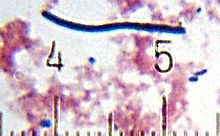Lactobacillus, also called "Döderlein's bacillus", is a genus of Gram-positive facultative anaerobic or microaerophilic rod-shaped bacteria. They are a major part of the lactic acid bacteria group. In humans they are present in the vagina and the gastrointestinal tract, where they make up a small portion of the gut flora. They are usually benign, except in the mouth where they have been associated with cavities and tooth decay (dental caries). Many species are prominent in decaying plant material. The production of lactic acid makes its environment acidic, which inhibits the growth of some harmful bacteria. Several members of the genus have had their genome sequenced.
Biology and biochemistry

Lactobacillus is Gram-positive (they retain crystal violet dye), facultative anaerobic (can use anaerobic respiration when oxygen is not present). Lactobacillus is a member of the lactic acid bacteria group (its members convert lactose and other sugars to lactic acid).
Metabolism
Many lactobacilli operate using homofermentative metabolism (they produce only lactic acid from sugars), and some species of lactobacilli use heterofermentative metabolism (they can produce either alcohol or lactic acid from sugars). They are aerotolerant despite the complete absence of a respiratory chain. This aerotolerance is manganese-dependent and has been explored (and explained) in Lactobacillus plantarum. Many lactobacilli do not require iron for growth and have an extremely high hydrogen peroxide tolerance.
Taxonomy

The genus Lactobacillus currently consists of over 180 species and encompasses a wide variety of organisms. The genus is polyphyletic, with the genus Pediococcus dividing the L. casei group, and the species L. acidophilus, L. salivarius, and L. reuteri being representatives of three distinct subclades. The genus Paralactobacillus falls within the L. salivarius group. In recent years, other members of the genus Lactobacillus (formerly known as the Leuconostoc branch of Lactobacillus) have been reclassified into the genera Atopobium, Carnobacterium, Weissella, Oenococcus, and Leuconostoc. More recently, the Pediococcus species P. dextrinicus has been reclassified as a Lactobacillus species (IJSEM, Paper in Press).
According to metabolism, Lactobacillus species can be divided into three groups:
- Obligately homofermentative (Group I) including:
- L. acidophilus, L. delbrueckii, L. helveticus, L. salivarius
- Facultatively heterofermentative (Group II) including:
- L. casei, L. curvatus, L. plantarum, L. sakei
- Obligately heterofermentative (Group III) including:
- L. brevis, L. buchneri, L. fermentum, L. reuteri
Usage in humans

Probiotics and biotherapeutics
Some strains of Lactobacillus spp. and other lactic acid bacteria may possess potential therapeutic properties including anti-inflammatory and anti-cancer activities, as well as other features of interest. A study by researchers from the Beth Israel Deaconess Medical Center and UCLA in 2009 demonstrated the protective effects of some strains of these bacteria for anti-tumor and anti-cancer effects in mice.
Lactobacilli can also be used to restore particular physiological balance such as in the vaginal eco-system. Their role is (1) to physically protect the vaginal epithelium by building a thick layer separating the epithelium from pathogens, (2) to physiologically keep the balance of the vaginal ecosystem in maintaining the pH at ~4.5, and (3) generating hydrogen peroxide against pathogens. Lactobacilli are highly tolerant to low pH and can easily maintain low pH and protect the vaginal eco-system from Gram-negative and Gram-positive bacteria.
Food production
Some Lactobacillus species are active in the production of yogurt, cheese, sauerkraut, pickles, beer, wine, cider, kimchi, cocoa, kefir, and other fermented foods, as well as animal feeds.
Sourdough bread is made using a "starter culture," which is a symbiotic culture of yeast and lactic acid bacteria growing in a water and flour medium. The bacteria metabolize sugars into lactic acid, which lowers the pH of their environment, creating a signature "sourness" associated with yogurt, sauerkraut, etc.
In many traditional pickling processes, vegetables are submerged in brine, and salt-tolerant lactobacillus species feed on natural sugars found in the vegetables. The resulting mix of salt and lactic acid is a hostile environment for other microbes, such as fungi, and the vegetables are thus preserved -- remaining edible for long periods.
Lactobacilli, especially L. casei and L. brevis, are some of the most common beer spoilage organisms. They are however essential to the production of sour beers such as Belgian Lambics and American Wild Ales, giving the beer a distinct tart flavor.
Dental caries
While streptococci family bacteria (e.g. Streptococcus mutans) are the main cause of tooth decay, other varieties of microbes can cause dental caries, but to a lesser extent. For example, although considered beneficial, some Lactobacillus species have been associated with dental caries. The Lactobacillus count in saliva has been used as a "caries test" for many years. This is one of the arguments used in support of the use of fluoride in toothpaste. Lactobacilli characteristically cause existing carious lesions to progress, especially those in coronal caries. The issue is, however, complex as recent studies show probiotics can allow beneficial lactobacilli to populate sites on teeth, preventing streptococci pathogens from taking hold and inducing dental decay.[1]
See also
- Firmicutes
- Lactic acid bacteria
- Lactic acid fermentation
- MRS agar
- Paralactobacillus
- Pediococcus
- Probiotics
References
External links
- Prakash, S. et al. “The Gut Microbiota and Human Health with an Emphasis on the Use of Microencapsulated Bacterial Cellsâ€, Journal of Biomedicine and Biotechnology (2011),
- Data related to Lactobacillus at Wikispecies
- List of species of the genus Lactobacillus




0 komentar :
Posting Komentar